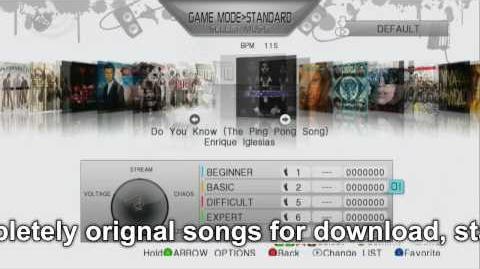
You go, girl.
Will it set the dancing world on fire?[]
When I think of arcades, I think of DanceDanceRevolution (DDR). Its intense, rhythm-based gameplay not only helped uncoordinated gamers exercise, but it also served as our window into the delightful oddities found in Japan's gaming world. DDR has made an appearance on a number of consoles and now players will be able to dance frantically with DanceDanceRevolution on the PlayStation 3.
The newest title in the sweat-inducing line of games offers more of the same gameplay we've come to expect, along with the inclusion of Move support. It's a polished game with a diverse track list, but some odd issues hold back an otherwise enjoyable experience. It's also based on an outdated formula that's been surpassed by other dance games available today.
DanceDanceRevolution uses the same formula as its predecessors: directional arrows flow up the screen towards a "Step Zone" at the top of the display. When the arrow crosses the corresponding marker in the Step Zone, players step on the indicated part of the included dance mat. The more accurate steps a player completes, the more points they earn. As players complete the steps, the Groove Gauge fills up. When it caps off, players can activate the Groove Trigger, which adds a multiplier to the points they earn. This is all traditional stuff for DanceDanceRevolution, and it still works. The track list is a sticking point for DDR enthusiasts, and the tunes in this DanceDanceRevolution make for an interesting set. A number of popular American songs like Lady Gaga's "Bad Romance" and Paramore's "crushcrushcrush" are included alongside several older tracks like "Celebration" by Kool and the Gang. Most are fun to dance to and work well with DanceDanceRevolution's style. A handful of the high-intensity Japanese songs that DDR veterans love also make the cut, but most of the initial tracks are American. Luckily, more tracks can be unlocked on top of the initial 30.
Incorporating your upper body is where Move support comes into play. The Step & Move mode tasks players with hitting on-screen targets with the Move controller while dancing normally. There are four targets -- one in each corner of the screen. When the icon for the upper right target appears, players move their hand towards that target in time with the music. This mode adds an extra layer to the experience, which is refreshing for long-time DDR players that want a new challenge. The Step & Move gameplay is similar to the motion functionality found in previous Wii versions of DanceDanceRevolution, but it's more accurate here.
Overall, I was happy with Step & Move. It's more difficult than the traditional modes, and hitting the on-screen targets is a fine way to mix things up.
For those bored of the typical modes, the additional ones are a good way to mix it up. The Club Mode strings a set of songs together with special challenges tossed in to keep players on their toes (no pun intended). The Dance Off game type pits multiple players against one another in an attempt to own the most arrows in a song. This is done by taking turns on a looped track and working to be the most accurate dancer of the bunch. IGN Editor Jack DeVries and I played through this mode and enjoyed it because it brings a more immediate competition to the formula. It's about as close to a dance battle as you're going to get here.
Both Club and Dance Off are appreciated, but I'm especially happy with the included tutorials. This was a smart idea on the developers' part to bring in newcomers, and giving players the ability to practice songs (or parts of songs) at a slower pace is invaluable. You'll need to slow down songs and practice, too, because DanceDanceRevolution has some issues that make it occasionally brutal. There's a massive difficulty spike between the Basic and Difficult settings. On Basic, things are way too easy for me, but jumping to Difficult seems steeper than it should be -- and Difficult isn't even the hardest setting available. Also mindboggling is the lack of a pause button. Perhaps there's a secret pause feature that I'm not aware of, but no button on my mat or controller paused the game. Oversight? I'd say so.
Along with difficulty and interface, the thing that holds DanceDanceRevolution back the most is its age. This is largely the same game we've seen for years. This is a good thing for those that have happily followed it, but I personally want something more out of a dance game. The tech has evolved to a point where we don't necessarily need to follow a set of four arrows to "dance." There's more realistic ways to bring dancing into games. The Kinect title Dance Central, which involves real dancing with no peripherals, makes dance pad games feel antiquated.
Closing Comments[]
DanceDanceRevolution is a fine purchase for those that feel the urge to stomp their feet to glowing arrows, but the gameplay hasn't changed dramatically over the years. The inclusion of Move support and other specialized modes makes this dance experience a well-rounded and ultimately enjoyable one, but it won't usher in a new legion of DDR fans considering the game's excellent competition.
